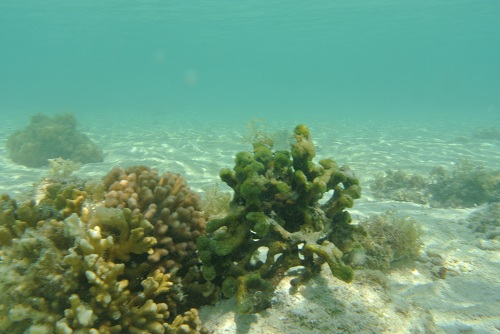Ecology
Symbioses are very common in the animal as well as in the plant kingdom and have been of interest for scientists for many years. In marine environments, symbioses between invertebrates such as corals or sponges and photosynthetic microorganisms are very abundant and important, not just for the individuals themselves but often for the whole ecosystem such as tropical coral reefs (Vacelet, 1981).
Sponge/Algal Symbiosis
Indeed, sponges form more symbioses with more species of algae than any other animal phylum (Trautman & Hinde, 2001). These symbiotic associations occur within the class Demospongiae, which contains 80 to 90% of all sponge species (Trautman & Hinde, 2001; Ruppert et al., 2004). Sponge/Algal associations are not restricted to tropical regions but can also be found in temperate and polar waters, even though their abundancy and distribution is not as diverse as in tropical waters (Trautman & Hinde, 2001).
Haliclona/Ceratodictyon

The Haliclona/Ceratodictyon association in its natural habitat on Heron Island. (Photo: Ronja Schmidt)
The sponge Haliclona cymaeformis and its symbiotic partner, the red macroalga Ceratodictyon spongiosum can usually be found on shallow reefs and reef flats (Vacelet, 1981; Price et al., 1984; Trautman et al., 2000; Trautman et al., 2003). The association does not necessarily need solid substrata such as coral rubble to attach to but is also found to be mobile. Shallow reefs and reef flats are often featured by high water turbulence (Trautman et al., 2000; Trautman et al., 2003) and therefore fewer other macroscopic organisms survive there. Haliclona cymaeformis can settle under these conditions because its algal partner provides a strong supportive structure (Trautman et al., 2000). Furthermore, permanent water movement is essential for the association’s growth because it guarantees circulation, therefore enables respiration and the provision of food and nutrients for the filter feeding sponge and the phototrophic alga (Trautman et al., 2000). In reverse, Haliclona/Ceratodictyon is nearly absent in areas that are characterized by less rapid water movements. These shallower waters are populated by other large, phototrophic sponges (Trautman & Hinde, 2001).
Sponge/Algal Symbioses on coral reefs, especially of the southern hemisphere, make a major contribution to the benthic primary productivity in the areas where they are found. Indeed, in some areas Haliclona/Ceratodictyon contributes up to 50% of the total reef flat primary productivity (Trautman & Hinde, 2001).
|